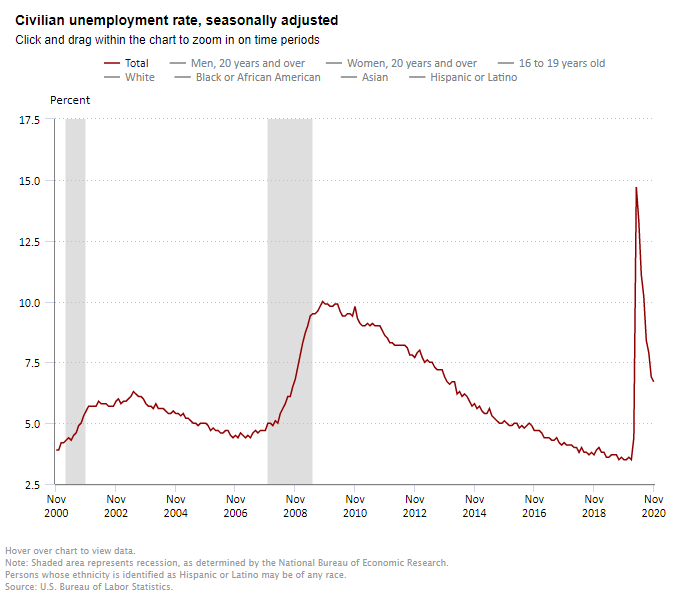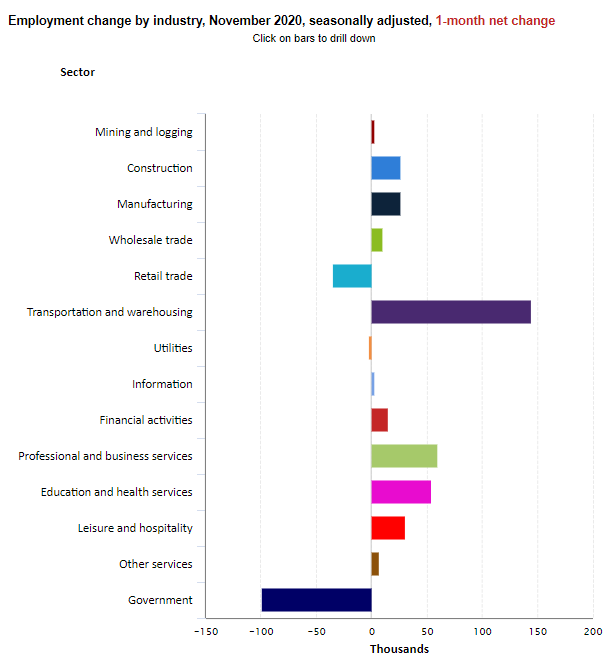The Labor Department reported that nonfarm payrolls rose by 245,000 in November and that the unemployment rate fell to 6.7% from 6.9% in October. This suggests that the employment recovery from the COVID-related drop in March and April continues, but at a decelerating pace. The consensus estimates for November had been for a gain of 470,000. In November, nonfarm employment was below its February level by 9.8 million jobs or by 6.5%.
Health care added 46,000 jobs in November, with the largest gains occurring offices of physicians and home health care services. Health care employed 527,000 fewer workers in November than in February. Nursing care facilities lost 12,000 jobs in November.

The 0.2 percentage point drop in the November unemployment rate to 6.7% marked the seventh consecutive month of improvement. It is 3.2 percentage points above the pre-pandemic level of 3.5% seen in February, however, but well below the 14.7% peak seen in April.
The number of long-term unemployed (those jobless for 27 weeks or more) increased by 385,000 to 3.9 million, a figure that suggests that is continues to be a very challenging time for many Americans. Long-term unemployed persons account for 36.9% of the total number of unemployed persons. The number of permanent job losers rose 59,000 to 3.7 million and is 2.5 million more than in February.
The underemployment rate or the U-6 jobless rate fell to 12.0% in November from 12.1% in October. This figure includes those who have quit looking for a job because they are discouraged about their prospects and people working part-time but desiring a full work week.
A separate report issued yesterday on unemployment insurance claims showed that more than 20.2 million workers remain on government assistance in the week ended November 14.
Average hourly earnings for all employees on private nonfarm payrolls rose by $0.09 in November to $29.58, a gain of 4.4% from a year earlier. The large employment fluctuations over the past several months, especially in industries with lower-paid workers—complicate the analysis of recent trends in average hourly earnings.

The labor force participation rate, which is a measure of the share of working age people who are employed or looking for work slipped to 61.5% in November, down from 61.7% in October. The employment-population ratio was little changed at 57.3% in November and is 3.8 percentage points lower than in February.
The change in total nonfarm payroll employment for September was revised up by 39,000 from 672,000 to 711,000 and the change for October was revised down by 28,000 from 638,000 to 610,000. Combined, 11,000 jobs were added to the original estimates. Monthly revisions result from additional reports received from businesses and government agencies since the last published estimates and from the recalculation of seasonal factors.
The slowdown in monthly gains in employment is troubling. Further weakness in employment growth is likely due to the ongoing large number of newly diagnosed COVID-19 infections and its impact on business closures and job security. Many states are re-imposing lockdowns. Congress needs to act to implement further fiscal stimulus to keep the recovery on track. Without a fiscal stimulus package, the recession is likely to deepen until a vaccine can be safely and widely distributed.
About Beth Mace
Beth Burnham Mace is a special advisor to the National Investment Center for Seniors Housing & Care (NIC) focused exclusively on monitoring and reporting changes in capital markets impacting senior housing and care investments and operations. Mace served as Chief Economist and Director of Research and Analytics during her nine-year tenure on NIC’s leadership team. Before joining the NIC staff in 2014, Mace served on the NIC Board of Directors and chaired its Research Committee. She was also a director at AEW Capital Management and worked in the AEW Research Group for 17 years. Prior to joining AEW, Mace spent 10 years at Standard & Poor’s DRI/McGraw-Hill as director of its Regional Information Service. She also worked as a regional economist at Crocker Bank, and for the National Commission on Air Quality, the Brookings Institution, and Boston Edison. Mace is currently a member of the Institutional Real Estate Americas Editorial Advisory Board. In 2020, Mace was inducted into the McKnight’s Women of Distinction Hall of Honor. In 2014, she was appointed a fellow at the Homer Hoyt Institute and was awarded the title of a “Woman of Influence” in commercial real estate by Real Estate Forum Magazine and Globe Street. Mace earned an undergraduate degree from Mount Holyoke College and a master’s degree from the University of California. She also earned a Certified Business Economist™ designation from the National Association of Business Economists.
Connect with Beth Mace
Read More by Beth Mace